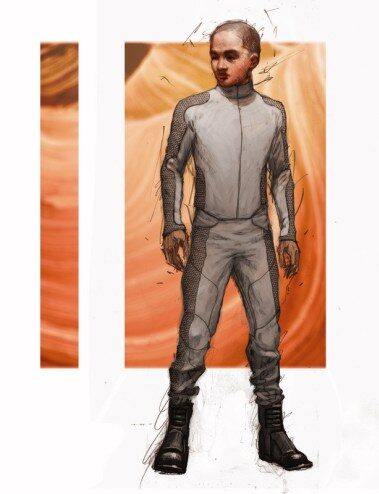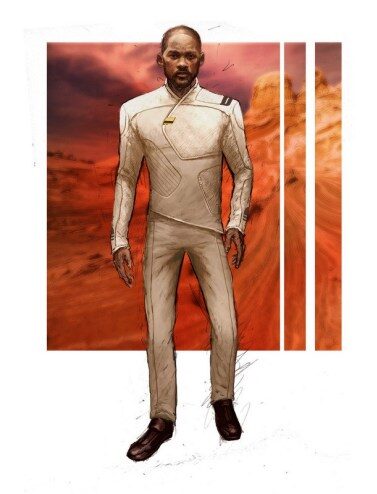After Earth: Costume Designer Amy Westcott Explains Life Suit | Clothes on Film – Part 32030

After Earth is Amy Westcott’s first attempt at a sci-fi feature. Her M.O tends to be contemporary costume, such as The Wrestler (2008) and award winning work on Black Swan (2010). But even then she seeks out subtext amongst typical genre interpretation. Black Swan for example is a psychological horror whereby costume reflects the inner workings of the protagonist’s mind so actually becomes part of the narrative. After Earth is similar in this respect because the film’s primary ensemble, the ‘life suit’ worn by Kitai Raige (Jaden Smith) is synthetic in construction yet organically synched with the human body. Without his suit, Kitai could not survive Earth’s hazardous environment; his mission would be over before it began.
Clothes on Film recently caught up with Amy Westcott to ask about her remit for After Earth, creating the life suit and the realities of ‘smart fabric’. Exclusive costume illustrations by Brian Valenzuela.
Ranger cadet uniform worn by Jaden Smith as Kitai Raige.
Clothes on Film: What was your overall brief for the costume design of After Earth?
Amy Westcott: From the first meetings with director M. Night Shyamalan, it was clear that he did not want to make a superhero movie. We were making a futuristic film that was grounded in reality. The idea was that this was somewhat of a utopian society. Definitely not post apocalyptic in any way. They had gotten past that time period. The life suit worn by Jaden Smith was not part of his body- it was a military issued suit that could protect him, as well as giving him special abilities, like flying.
CoF: Did you watch any classic sci-fi for inspiration? Dune, Star Wars..?
AW: I did, but I found that futuristic costumes are so subjective. It was more inspirational for me to research technology, especially in terms of fabric. There are so many revolutionary things happening.
Kitai’s life suit. Cold and dying state is yellowish with a grey undersuit.
CoF: Please explain Kitai’s life suit in context of the story; it changes colour based on heat, sprouts wings…
AW: Actually, the colour changing was not originally part of the story. A lot of my research centred around various beetles, and there are many things that they do that I used in the designing of the life suit. For instance, some turn black in danger, and some lose their colour when dying. Night liked the idea so much that he worked the whole colour changing idea into the script.
All of its other uses were in the script. The suit is commentary on how advanced their society is.
CoF: How did you make this suit work in practical terms? Presumably you needed several versions?
AW: We needed so many suits. I suppose you always do when something is worn over 3/4 of the movie, but we had the extra challenge of a growing 13 year old body! But in practical terms, Jaden had to be extremely agile – there were tons of stunts and days of running. The suit had to be flexible, durable and comfortable enough to wear for 10-12 hours a day.
Kitai’s life suit in black danger/protection mode. Red/brown with dark grey under-layer (main image) is the suit’s natural state. Click to see the beetle references Amy Westcott used for the colour scheme: DYING, DANGER and NATURAL.
CoF: How was the final synthetic/organic design reached? It’s a clever mesh that avoids the cold technology overkill present in most sci-fi.
AW: That was very important to me. Since the futuristic world was based on science, the costumes had to be more grounded and organic to avoid the cold look. I based all of my research on nature. Everything that his suit could do was derived from something organic. For instance, the fabric of his “undersuit” was based on the underside of a mushroom. The mushroom gathers water for the plant using these gills. I replicated the look of the mushroom gills onto fabric with a 3 dimensional print to show that the suit collects water in the same way for the wearer.
CoF: In the film the suit is made from ‘smart fabric’, but what is it actually constructed from?
AW: The undersuit is a knit fabric from Italy that was printed while the overlayer, or the “mechanics” of the suit are molded foam latex. We also worked hard to make the finish look organic and not identifiable as any fabrication that we are familiar with. Several colours and textures were applied to the foam latex in order to achieve this.
Ranger dress uniform worn by Will Smith as Cypher Raige.
CoF: And the boots?
AW: I wanted the boots to be an extension of the suit, but avoiding the one piece look. They had to retain the same qualities, yet look separate. The biggest challenge with the boots was making them appropriate for all terrains. He was climbing wet trees, parkouring off rocks and doing a ton of running. They also had to be very comfortable, lightweight, and I wanted them to be clear urethane. No existing sole covered all the bases, so we made our own.
CoF: Tell us about the Ranger’s dress and battle uniforms.
AW: I tried to keep the rangers uniforms in the organic world as well. Their ships were derived from stingrays, so they all had a stingray skin badge on their chests. Ranking system was shown by shapes formed under their uniforms on the opposite side. The colour was the new planet’s camouflage. It was important to me, when designing them, that they look strong but not ridiculously aggressive.
‘Nature’ dress worn by Sophie Okonedo as Faia Raige.
CoF: How about Sophie Okonedo’s dresses as Faia Raige?
AW: (the dress above) was made out of an amazing knit fabric called Eurojersey that, ironically, is being used a lot lately for superhero costumes. It prints, dyes and holds its shape beautifully. All of her prints were derived from nature (trees, for example), and I used Japanese (simple and elegant) fashion as inspiration on the dress shapes. Pattern Magic by Tomoko Nakamichi is genius and really gets your brain to move outside the box.
With thanks to Amy Westcott.
Illustrations by Brian Valenzuela.
After Earth is currently on general release.
© 2013 – 2014, Lord Christopher Laverty.




